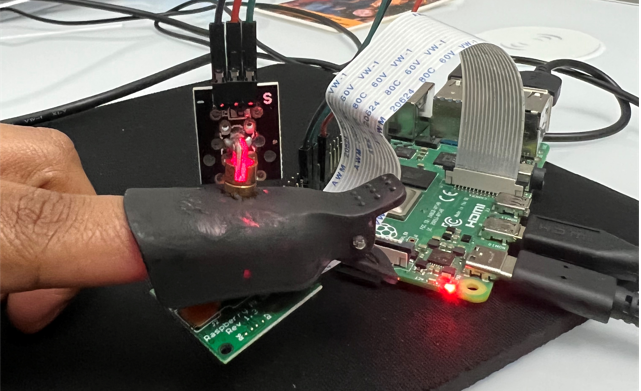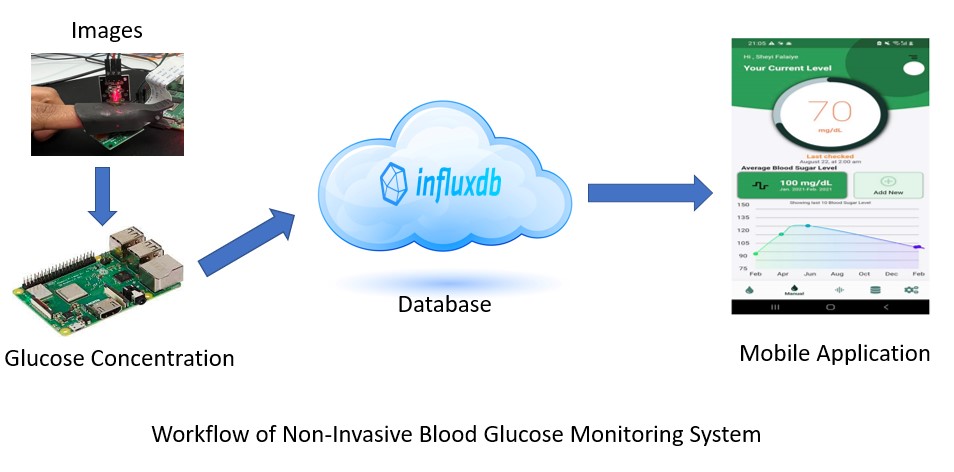Non-Invasive Blood Glucose Monitoring System for Diabetes Management using IoT
Diabetes Mellitus is a chronic disease that affects the human body by impairing it from producing, responding, or utilizing a hormone called insulin. This disease is commonly diagnosed in adults 40 to 65 years of age. Although there is no cure for Diabetes, it can be kept in check by maintaining a healthy lifestyle and monitoring the blood-glucose readings on a timely basis. The standard method for monitoring blood glucose is invasive, which involves needles, lancets, and blood samples that cause a lot of discomfort and stress. To reduce the use of invasive approaches for monitoring blood glucose, this research proposes building and testing a non-invasive glucose monitoring prototype that does not require any blood sample and does not involve any kind of invasive procedure. Our system is based on inexpensive devices such as a Raspberry Pi (RPi), a portable camera (RPi camera), and a visible light laser. A set of pictures would be taken using the RPi camera when a visible light laser passes through the human tissue. Using this image dataset to study the absorption and analyze how light is scattered along with the human tissue, the glucose concentration can be estimated by an ANN (Artificial neural network) model. Our AI model is developed using TensorFlow, Keras, and Python code. Preliminary results with limited data exhibit an accuracy of around 90%, which is promising for more extensive experimentation.

Components Used in the Prototype
- Raspberry Pi Board
- Raspberry Pi Camera
- Visible Light Laser
- SD Card
- Finger Clip
- Power Adaptor
- Micro HDMI Cable
- Mouse
- Keyboard
- Desktop
Workflow

- We designed and developed a prototype that is used to capture images from the finger or ear with the help of a Raspberry Pi camera and laser light and continuously measure the blood sugar concentration with the help of a Raspberry Pi device.
- We developed a methodology to input images captured from light absorption to a neural network for blood sugar estimation.
- The glucose concentration obtained from the ANN model is sent to the Cloud using Hypertext Transfer Protocol Secure (HTTPS). We configured an InfluxDB database which is an open-source database used for storage and retrieval of time series data.
- We developed a mobile application that is connected to our Cloud InfluxDB database that helps the users to view the most recent and previous glucose estimation measurements in real-time and also graphically visualize the glucose variation over time. The mobile application is also configured to send customized alerts when sudden changes occur.
GlucoCheck paper for Journal
- Development of a Non-Invasive Blood Glucose Monitoring System Prototype: Pilot Study. Valero, Maria; Pola, Priyanka; Falaiye, Oluwaseyi; Ingram, Katherine; Zhao, Liang; Shahriar, Hossain; Ahamed, Sheikh. Journal of Medical Internet Research (Formative Research), 2022.
- Comparative Study of Machine Learning Methods on Spectroscopy Images for Blood Glucose Estimation. Kazi, Tahsin; Ponakaladinne, Kiran; Valero, Maria; Zhao, Liang; Shahriar, Hossain; Ingram, Katherine. EAI International Conference on Pervasive Computing Technologies for Healthcare , 2023.
